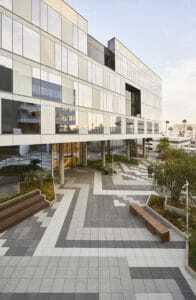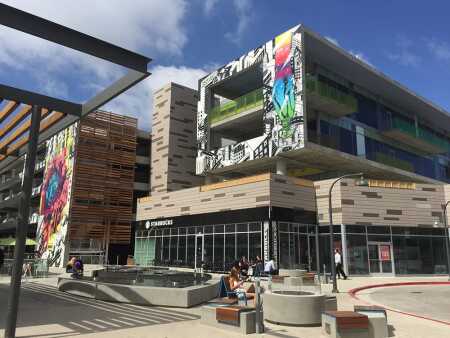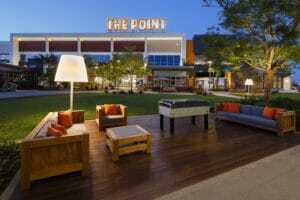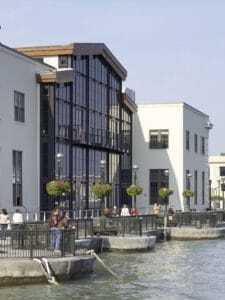With an expanding economy fueled by the technology, aerospace, and life sciences industries—to say nothing of traditional mainstays entertainment, tourism, and agriculture—the Golden State boasts increasing demand for real estate, particularly for residential and in urban areas, and supply is constrained.

For Columbia Square, a $450 million mixed-use campus on the site of the former CBS West Coast studios in the Hollywood neighborhood of Los Angeles, Kilroy Realty partnered with architect/planner/landscape architect Rios Clementi Hale Studios. Anchor tenants include NeueHouse, Viacom, Fender, and the Hollywood Proper luxury residential tower. Main completion is expected in the middle of this year. (Spencer Lowel)
That combination is powering increased real estate development and attracting investors from around the world. With limited land available for new projects in many areas, multifamily housing developers are even expanding vertically, relying on innovative and sustainable landscaping to make their developments more attractive. Even so, these entrepreneurs face a number of challenges.
“California continues to experience very strong investment interest from a number of areas, including Pacific Rim nations such as Australia,” says Ron Silverman, partner in the Cox, Castle & Nicholson law firm, who is located in its Los Angeles office. “That interest is not confined to trophy buildings/projects, but extends across most sectors, including, interestingly enough, agriculture.”
While California real estate remains in high demand for both domestic and foreign investors, some clouds are appearing, says Matt Marquis, chief executive officer and president of Invest West Financial of Santa Barbara, a real estate and private equity investment firm focused on repositioning hospitality projects along California’s coast.
“There appears to be a widening gap between what buyers will pay and what sellers are demanding,” he says. “It feels like the beginning of a softening of pricing.”
Even so, funding, while not as bountiful as it was 18 months ago, remains available for viable real estate projects in the state.
“There are definitely opportunities for developers to get their projects financed,” says Bryan Shaffer, principal at George Smith Partners, a national real estate investment banking firm based in Los Angeles. “Debt and equity [financing] is available. But potential borrowers must have a good business plan, a solid track record, and an understanding that relationships are more important than ever. Lenders are being smarter, reevaluating risk and reward for each development in California. A good project can obtain funding, but mediocre deals probably won’t be funded.”

Runway at Playa Vista—developed by Lincoln Properties and sold to Invesco Real Estate in February—has a new mixed-use commercial and social center for Playa Vista, a development on the west side of Los Angeles that has attracted multiple tech companies. Architect Johnson Fain designed the development as an animated main street with nearly 200,000 square feet (19,000 sq m) of retail and restaurant space, including a Whole Foods Market and a Cinemark Theater. (Johnson Fain)
Counting On Tech
High technology continues to drive much of the development in California, and for good reason. The state received more venture capital in 2015 than all the other 49 states combined: of the total $59.7 billion in funding, $34.2 billion was earmarked for the Golden State, according to calculations by the Los Angeles County Economic Development Corporation’s nonprofit Kyser Center for Economic Research, based on figures from PwC’s MoneyTree report.
“The fact that two of the world’s leading research universities, Stanford and the University of California, Berkeley, are in California means innovation will continue,” notes Robert Anderson, principal at San Francisco’s Field Paoli Architects. “These well-known educational institutions and others around the state are producing young people with entrepreneurial spirit and skills that will benefit the state and society as a whole.”

Pacifica Hotels, the Irvine hospitality arm of Santa Barbara real estate developer Invest West Financial, is expected to complete renovation of Venice Beach’s the Kinney hotel this summer. The property has 68 guest rooms and an outdoor deck featuring a full BYOB bar and ping pong tables. (Pacifica Hotels)
With a growing base of high-tech and green energy companies, an emerging art and dining scene, and a younger, hipper crowd bringing energy, money, and jobs to the area, Oakland is finally emerging from the long shadow of its neighbor to the west, San Francisco.
Following years of city-sponsored and private redevelopment efforts, Oakland is a real estate hotspot, says Anderson.
“Ride-hailing giant Uber Technologies’ move next year to downtown Oakland means more high tech is shifting across the bay,” he says. “Young tech workers want to live in cities. They are moving to Oakland, supporting new economic development.”
In anticipation of more high-tech activity, Oakland is seeing a surge in multifamily development, says Stephen Jackson, senior vice president at financial and professional services firm JLL’s multifamily Capital Markets Group in San Francisco.
Two major apartment projects under construction in Oakland’s Uptown District are the 423-unit 3093 Broadway, a joint venture between Los Angeles–based Cityview and global investment manager Blackstone; and a 206-unit tower at 1700 Webster, being developed by Portland, Oregon, firm Gerdling Edlen.
“In addition, a dozen high- and mid-rise projects are about to break ground within blocks of Oakland’s two downtown Bay Area Rapid Transit [BART] stations,” says Jackson. “The city has historically not been an institutional investment market, but because of the 12-minute BART ride to downtown San Francisco, many major institutional investors have become owners of Class A residential towers, and even foreign investors want to own residential properties in the city.”
Those individuals with an entrepreneurial spirit are creating increased demand in urban office and residential markets, among other real estate sectors, says Alicia Esterkamp Allbin, principal at real estate development and investment company Pacific Waterfront Partners in San Francisco.
“Office users want to be in the urban center,” she continues. “People want to live there. The critical component is going to be building enough housing that is affordable for companies’ talent pools.”
Flexible planning remains a critical component in today’s quickly changing California markets, Esterkamp Allbin adds. “The intersection of housing, office, and retail—the live/work/play mode of urban living—is something that is here to stay,” she says.
“Projects that embrace public space and pay special attention to the types of tenants and their compatibility with the community and evolving market demands are ultimately of great importance to our cities,” Esterkamp Allbin says. “Public community spaces enhance the value of projects while also providing a tool for further integrating projects into their surrounding communities. These public spaces and amenities are extensions of people’s work and home lives, which are increasingly blended in today’s economy.”
Residential Trends
Residential property remains in high demand, although the state continuously struggles to provide sufficient housing that is affordable, particularly when job creation and other economic indicators are strong.
“In California, real estate development always faces a difficult tension between a deep-seated urge to preserve the land for recreational, aesthetic, and habitat values and a persistent need to accommodate a growing population and a dynamic economy,” says Robert Doty, a San Francisco–based partner in Cox, Castle & Nicholson. “That tension plays out most frequently in battles over entitling significant new projects, with many of those battles generating long entitlement processes and then litigation over the approvals.” Thus, development of attainable for-sale housing in California is increasingly critical, says Chris Texter, principal at KTGY Architecture + Planning of Irvine. Some municipalities are helping meet the challenge through legislation, he says.

To attract more visitors and keep guests longer, Federal Realty Investment Trust turned to Lifescapes International to create a large central courtyard for exercise classes, concerts, and other community events at the Point, Federal’s 115,000-square-foot (11,000 sq m) shopping, dining, and entertainment destination in El Segundo. (©Snyder Langston)
“Los Angeles has created the Small Lot Ordinance to encourage homeownership in desirable areas that can otherwise be prohibitive to first-time buyers and others who may be priced out of the market,” Texter says.
“The development of a more compact footprint for single-family homes within existing neighborhoods dominated by apartments and rental properties changes the mind-set to ownership and long-term commitment to the existing neighborhood. KTGY has worked with more than 30 small-lot subdivisions in Los Angeles and now an increasing number in Orange County to bring more attainable single-family homes to market.”
One example is small-lot developer Planet Home Living of Newport Beach’s Prism development in the Eagle Rock neighborhood of Los Angeles, designed by KTGY. “Prism’s 15 homes are detached, with only six to eight inches [15 to 20 cm] between them,” Texter notes. “This creates fee-simple ownership rather than condo ownership, avoiding homeowners association fees and opening up options for loan programs.”
The Eagle Rock site plan creates internal streets with walkable plazas that circulate both pedestrians and automobiles, says Alan Scales, principal of KTGY. “The efficient, front-loaded nature allows for the creation of a small, private rear yard that extends the living space on the ground floor and creates a place for a family pet or home garden,” he says.
In addition to the challenge of acquiring land to develop residential projects in California and making them affordable, navigating a municipality’s approval processes remains key, says William Schulz, president of design firm ima, based in Newport Beach.

Pacific Waterfront Partners of San Francisco redeveloped the Piers, a historic rehab project on San Francisco’s waterfront. The Piers includes 64,000 square feet (6,000 sq m) of Class A office space and 19,000 square feet (1,800 sq m) of waterfront restaurant space. The development is listed on the National Register of Historic Places. (Tim Griffith)
“We’re seeing increased city staff movement, and term limits are adding to the difficulties in navigating approvals from cities and agencies,” Schulz says. “Additional challenges to approval are NIMBYs [not in my back yard activists], further powered by social media providing greater community organization and bargaining power.”
Ima is involved in 25 to 50 projects in Orange County, Los Angeles, and the Inland Empire, including the Exchange at Gateway, a 200-unit affordable housing development in El Monte being developed with Jamboree Housing Corporation. “Those 200 affordable units received over 1,500 applications,” Schulz notes. “Demand is up all over.”
With limited land available for development but demand steadily increasing, more real estate developers are opting to build upward and use innovative and sustainable landscaping to make their projects more appealing to clients. In the multifamily sector, roof decks are now central in creating the luxury experience many renters crave, says Julie Brinkerhoff-Jacobs, president and chief financial officer of Newport Beach–based landscape design firm Lifescapes International.
“It’s about making their home feel like a destination while enriching the lives of the residents,” she says. “Residents also want a true sense of community, with social areas to congregate. The trend for multifamily in California going forward is moving toward highly articulated gardens with modern styling, natural elements, and incredible amenities.”
The Marke, Newport Beach–based Lyon Living’s five-story, 300-unit luxury offering in Santa Ana, is one example of how landscaping is designed to create a destination. “At the Marke, Lifescapes International articulated this trend with a high-end edge and amenities that provide residents with beautiful outdoor space, including courtyard parks, fire pits, barbecues, entertainment areas, and a resort-style pool,” she says.
Retail and Transportation

California’s Cox, Castle & Nicholson represented the Emeryville Redevelopment Agency, which conveyed a 400,000-square-foot (37,000 sq m) site to redeveloper Madison Marquette for its Bay Street Emeryville project. Located at the foot of the San Francisco/Oakland Bay Bridge, the project encompasses two city blocks and includes 379 luxury apartments and townhouses, as well as more than 65 shops. (Madison Marquette)
Retail developers are also using distinctive environments to drive more visitors to properties and keep guests there longer. At the Point in El Segundo, Federal Realty’s 115,000-square-foot (11,000 sq m) shopping, dining, and entertainment destination, Lifescapes fashioned several outdoor “living rooms.” The firm also created a large central courtyard for use for exercise classes, concerts, movies, and other community events.
“Providing areas where people can socialize, take in a concert, spend time with family and friends, or just relax extends their total time at the development and offers opportunities to get them to stay for a meal or notice a store that they haven’t seen before,” says Brinkerhoff-Jacobs.
Transportation is also playing an important role in car-centric southern California real estate development. To support more infill development, many cities in California are beefing up their transit systems. In Los Angeles, the light-rail Expo Line opened in May, transporting passengers between downtown and Santa Monica.
“New development is occurring along many of these transit lines, and it is expanding the array of mixed-use projects throughout Greater Los Angeles and pointing the region toward a less automobile-dependent future,” says David Waite of Cox Castle & Nicholson. “That has potentially game-changing implications.”
The nation’s most-populous state is not only seeing new real estate development, but also the repositioning of older properties. Field Paoli Architects designed Fashion Outlets of San Francisco, an urban outlet retail development by Santa Monica–based mall operator Macerich. The developers expect to break ground in 2017.
“It is part of a larger vertical mixed-use development by national homebuilder Lennar, reusing the site of a demolished stadium—Candlestick Park—at the edge of San Francisco,” says Anderson.
Repositioning in the Golden State’s hospitality industry continues, too, as the sector reports rising occupancies and average daily rates with corresponding property values reaching new highs, says Marquis.
“In California hospitality, buzzwords like ‘lifestyle,’ ‘urban,’ ‘hip/hipster,’ ‘social,’ and ‘authentic’ continue to dominate in design,” he says. “We are also seeing new ideas like themed areas, fight clubs, larger common spaces, outdoor games, interactive elements, and surf/skate local motifs making appearances across the idea boards. Cool, unique, and inviting seem a winning combination.”
Invest West’s hotel management company Pacifica Hotels, one of the largest owners and operators of boutique hotels along California’s coast, continues to develop and redevelop new offerings ranging from its urban downtown Los Angeles Wayfarer project to San Simeon Pines, a nine-acre (3.6 ha) coastal ranch property on Moonstone Beach, north of San Luis Obispo. “The repositioned Hotel Hermosa outside Los Angeles on the Pacific Coast Highway and the hip, new hotel the Kinney in Venice Beach are among the most recent redevelopment projects slated to be completed this summer,” he says.
Strong performances by California’s primary industries—technology, aerospace, life sciences, entertainment, tourism, and agriculture—are expected to fuel future real estate development.
Mike Sheridan is a freelance writer in Richmond, Virginia.





![Western Plaza Improvements [1].jpg](https://cdn-ul.uli.org/dims4/default/15205ec/2147483647/strip/true/crop/1919x1078+0+0/resize/500x281!/quality/90/?url=https%3A%2F%2Fk2-prod-uli.s3.us-east-1.amazonaws.com%2Fbrightspot%2Fb4%2Ffa%2F5da7da1e442091ea01b5d8724354%2Fwestern-plaza-improvements-1.jpg)


